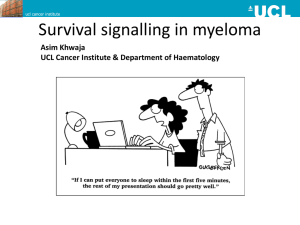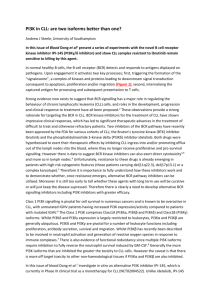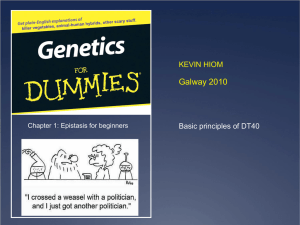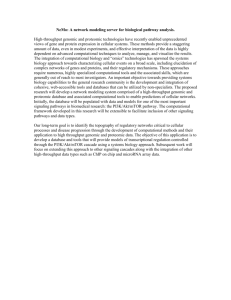Supplementary Information (doc 36K)
advertisement
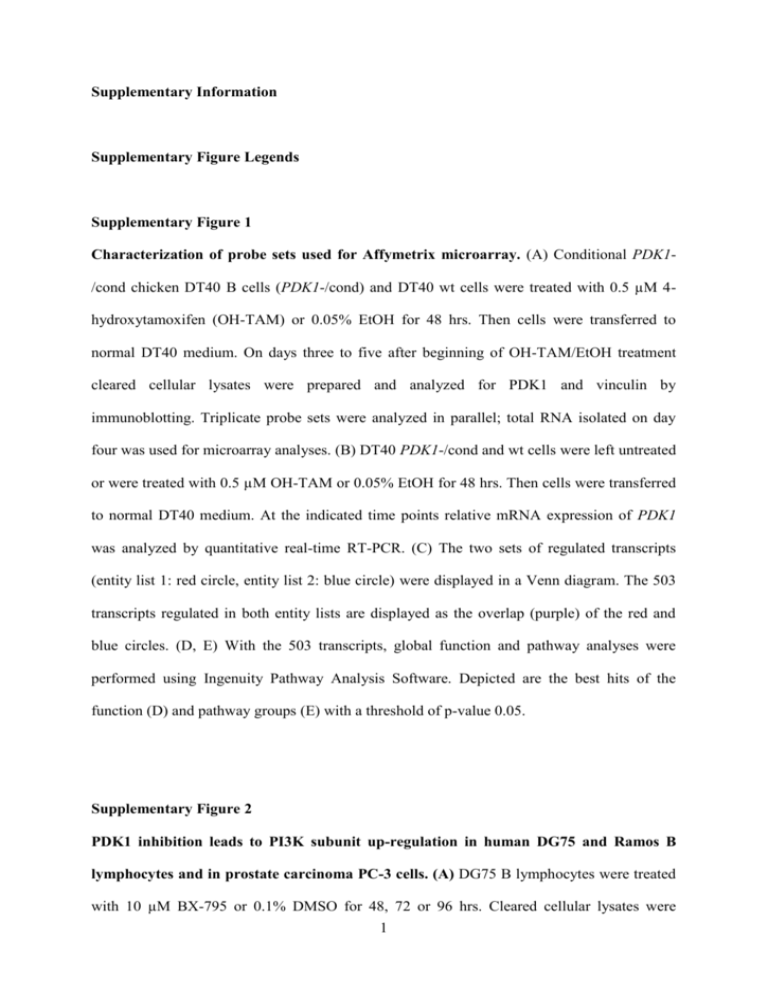
Supplementary Information Supplementary Figure Legends Supplementary Figure 1 Characterization of probe sets used for Affymetrix microarray. (A) Conditional PDK1/cond chicken DT40 B cells (PDK1-/cond) and DT40 wt cells were treated with 0.5 µM 4hydroxytamoxifen (OH-TAM) or 0.05% EtOH for 48 hrs. Then cells were transferred to normal DT40 medium. On days three to five after beginning of OH-TAM/EtOH treatment cleared cellular lysates were prepared and analyzed for PDK1 and vinculin by immunoblotting. Triplicate probe sets were analyzed in parallel; total RNA isolated on day four was used for microarray analyses. (B) DT40 PDK1-/cond and wt cells were left untreated or were treated with 0.5 µM OH-TAM or 0.05% EtOH for 48 hrs. Then cells were transferred to normal DT40 medium. At the indicated time points relative mRNA expression of PDK1 was analyzed by quantitative real-time RT-PCR. (C) The two sets of regulated transcripts (entity list 1: red circle, entity list 2: blue circle) were displayed in a Venn diagram. The 503 transcripts regulated in both entity lists are displayed as the overlap (purple) of the red and blue circles. (D, E) With the 503 transcripts, global function and pathway analyses were performed using Ingenuity Pathway Analysis Software. Depicted are the best hits of the function (D) and pathway groups (E) with a threshold of p-value 0.05. Supplementary Figure 2 PDK1 inhibition leads to PI3K subunit up-regulation in human DG75 and Ramos B lymphocytes and in prostate carcinoma PC-3 cells. (A) DG75 B lymphocytes were treated with 10 µM BX-795 or 0.1% DMSO for 48, 72 or 96 hrs. Cleared cellular lysates were 1 prepared and analyzed for PI3K p110, PI3K p85α and vinculin by immunoblotting. (B) Ramos B lymphocytes were incubated with the indicated concentrations of BX-795 or with DMSO (0.1% v/v) for 48 hrs. Cleared cellular lysates were prepared and analyzed for Akt, phospho-Akt (T308), GSK3β, phospho-GSK3β (S9), TSC2, phospho-TSC2 (S939), PI3K p110β, PI3K p110, PI3K p85α and actin by immunoblotting. Data shown are representative of three independent experiments. (C) Prostate carcinoma PC-3 cells were incubated with the indicated concentrations of BX-795 or with DMSO (0.1% v/v) for 48 hrs. Cleared cellular lysates were prepared and analyzed for Akt, phospho-Akt (T308), GSK3β, phospho-GSK3β (S9), TSC2, phospho-TSC2 (S939), FOXO1, phospho-FOXO1 (S256), PI3K p110β, PI3K p110 and actin by immunoblotting. Data shown are representative of three independent experiments. Supplementary Figure 3 Expression of chicken PDK1 reconstitutes wildtype phenotype in DT40 PDK1ko cells. (A) DT40 PDK1-/cond cells, retrovirally transfected with chicken PDK1 cDNA, were treated with 0.5 µM OH-TAM or 0.05% EtOH for 48 hrs or left untreated. Then cells were transferred to normal DT40 medium. On day four after beginning of OH-TAM/EtOH treatment cleared cellular lysates were prepared and analyzed for PDK1, PI3K p110β, PI3K p110, PI3K p85α, phospho-GSK3β (S9), GSK3β and Hsp90 by immunoblotting. Data shown are representative of three independent experiments. (B) Cells described in (A) were treated with 0.5 µM OH-TAM or 0.05% EtOH for 48 hrs. Then cells were transferred to normal DT40 medium. On days four to eight after beginning of OH-TAM/EtOH treatment apoptosis was assessed by propidium iodide staining of hypodiploid apoptotic nuclei and flow cytometry. Data shown are mean of triplicates ±SD and are representative of three independent experiments. 2 Supplementary Figure 4 Members of the FOXO and CREB transcription factor families are upstream regulators of regulated transcripts. (A) The two complete sets of regulated transcripts were analysed using Ingenuity Pathway Analysis (IPA) Software. Ingenuity’s Upstream Regulator Analysis in IPA is a tool that predicts upstream regulators from gene expression data based on the literature and compiled in the Ingenuity® Knowledge Base. A Fisher’s Exact Test p-value is calculated to assess the significance of enrichment of the gene expression data for the genes downstream of an upstream regulator. Supplementary Figure 5 Akt and mTORC1 inhibition lead to up-regulation of PI3K subunits in different human cell lines. (A) Jurkat T lymphocytes, DG75 B lymphocytes and Nalm-6 B lymphocytes were treated with 10 µM Akti-1/2/3 or 0.1% DMSO for 48, 72 or 96 hrs (DG75 and Jurkat only). Cleared cellular lysates were prepared and analyzed for PI3K p110, PI3K p85α (DG75 only) and vinculin by immunoblotting. (B) Jurkat T lymphocytes were treated with 100 nM rapamycin (Rapa) for 72 hrs. Cleared cellular lysates were prepared and analyzed for PI3K p110β, PI3K p110, PI3K p85α, phospho-Akt (T308 and S473), Akt1, phospho-GSK3β (S9), p70S6K, phospho-p70S6K (T389), vinculin, and GAPDH by immunoblotting. 3 Supplementary Materials & Methods Microarray analysis DT40 cells were incubated in medium containing 0.5 µM 4-hydroxytamoxifen (OH-TAM) or 0.05% EtOH as control. After 48 hrs OH-TAM treated cells were transferred to normal medium. On day four after beginning of OH-TAM/EtOH treatment total RNA was extracted using the RNeasy Micro Kit (Qiagen) according to manufacturer’s instructions for tissues. QIAshredder mini-spin columns (Qiagen) as well as needle and syringe homogenization were applied. RNA quality was observed with Agilent 2100 Bioanalyzer using RNA 6000 Nano LabChip Kit (Agilent Technologies, Böblingen, Germany) following the manufacturer’s instructions. Microarray experiments were performed using the Affymetrix™ platform according to manufacturer’s instructions. Fragmented and labeled cRNA were hybridized on Affymetrix™ GeneChip Chicken Genome Arrays. A probe-level summary was determined using the Affymetrix™ GeneChip Operating Software using RMA algorithm. Normalization of raw data was performed by the Array Assist™ Software 4.0 (Stratagene, La Jolla, Canada), applying a GC-robust multichip average (RMA) algorithm. Significance was calculated using a t-test without multiple testing correction (Array Assist™ Software), selecting all transcripts with a minimum change in expression level of 2-fold together with a p-value less than 0.05. Gene regulation networks Gene regulation networks were generated by Ingenuity Pathways Analysis 3.1 (http://www.ingenuity.com). For that purpose, data sets containing orthologs of gene identifiers and the corresponding expression and significance values were uploaded into the application. These genes, called Focus Genes, were overlaid onto a global molecular network developed from information contained in the Ingenuity Pathways Knowledge Base. Networks of these Focus Genes were then algorithmically generated based on their connectivity. 4 Functional classification of differentially expressed genes Functional Analysis was used to determine the biological functions that were most significant to the data set. Ortholog genes from the data set that met the negative logarithmic significance cut-off of two or higher, and were associated with biological functions in Ingenuity Pathways Knowledge Base were considered for the analysis. Fisher’s exact test was used to calculate a p-value determining the probability that each biological function assigned to that data set is due to chance alone. Genomatix-based promoter analyses The promoter regions of the genes encoding the PI3K subunits p110β, p110 and p85α, the phosphoinositide-modifying enzymes (INPP5B, PIP5K1-β), the PI3K interacting protein, and Lyn were analysed by performing transcription factor mapping using the Genomatix Software Suite v2.7 (http://www.genomatix.de). The promoters of the genes listed above were directly extracted from ElDorado database. Transcription factor binding sites were identified using MatInspector (Release professional 8.06, August 2012) with the library “MatInspector Release professional 8.06, August 2012”. Default parameters were used for the initial analyses in all programs, if not indicated otherwise. Upstream Regulator Analysis The two complete sets of regulated transcripts were analysed using Ingenuity Pathway Analysis (IPA) Software. Ingenuity’s Upstream Regulator Analysis in IPA is a tool that predicts upstream regulators from gene expression data based on the literature and compiled in the Ingenuity® Knowledge Base. A Fisher’s Exact Test p-value is calculated to assess the significance of enrichment of the gene expression data for the genes downstream of an upstream regulator. 5
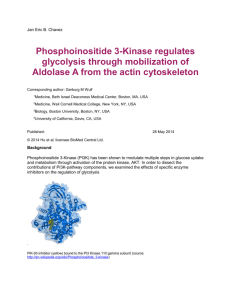

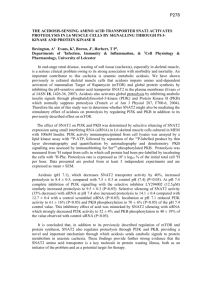
![Lipolysis[1] - IHMC Public Cmaps](http://s2.studylib.net/store/data/005358142_1-87bcfc0fc3c32a571191c55d07580764-300x300.png)
